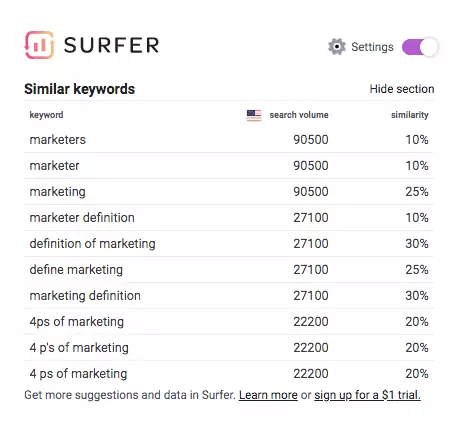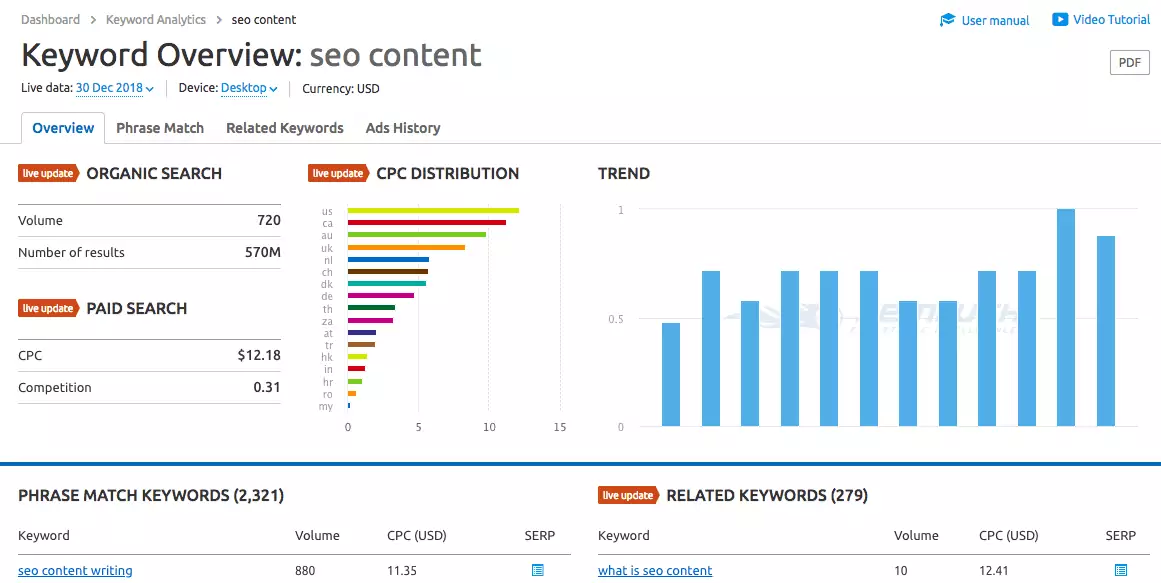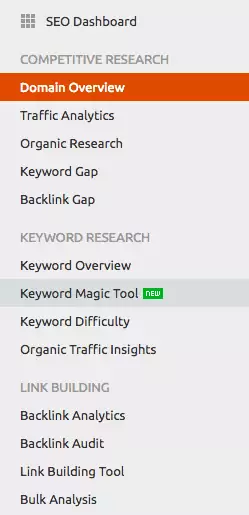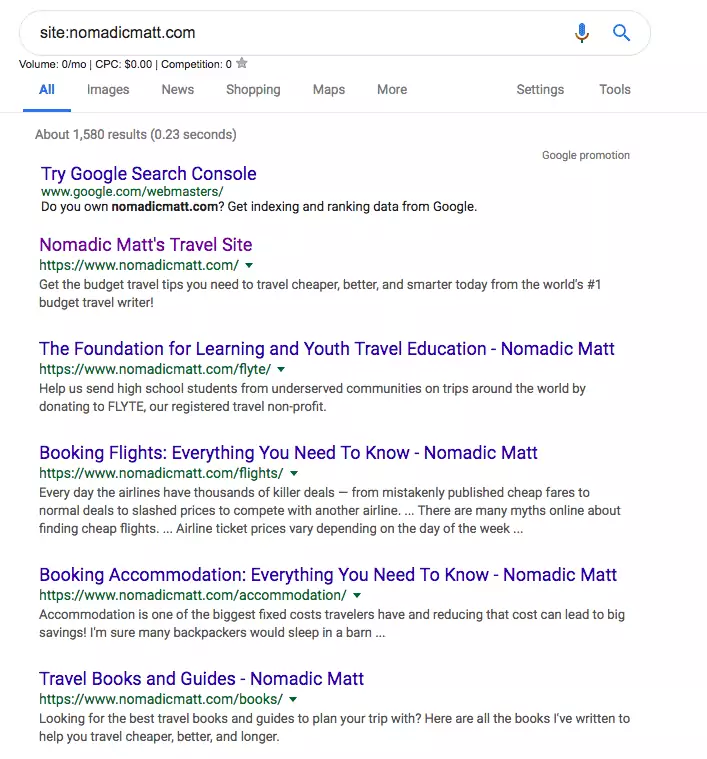Sometimes the creative juices just aren’t flowin’.
You feel like you have tackled every question and query in the book – and can’t come up with new blog post ideas. Your imagination piggy-bank is all cleaned out.
Fortunately, there’s a way to come up with engaging, SEO-friendly blog post ideas without relying on your own creative (or not creative) brain.
With this step-by-step guide, you’ll never run out of blog post ideas and you’ll have an endless stream of content to help your blog generate more SEO traffic.
Step-by-Step Guide for Coming Up with Blog Post Ideas
Whether you’re an SEO agency, a small business, or a blogger, publishing high-quality content is an essential part of generating more SEO traffic.
As an agency, it may be your responsibility to manage your client’s content marketing and get them the best ROI for their SEO investment.
As a business owner or blogger, the potential for SEO traffic lies in your hands – and depends on you writing and publishing content that your audience is actively searching for.
What we’re talking about are blog posts ideas that are supported by the data. This means that you don’t have to rely on racking your brain every month to come up with blog post topics out of thin air.
1. Get Yourself an SEO Keyword Tool ASAP
If you want to take your SEO seriously, it’s worth investing in premium SEO tools. Having access to accurate, reliable data ensures that you are picking the best keywords (i.e. the best blog post topics) for your website. There’s just no doubt about it.
However, not everyone has the dime to invest in a paid SEO tool right away. That’s why I suggest trying some of the tools below to get started.
Free Keyword Research Tools:
Keyword Surfer Chrome Extention
The Keyword Surfer Google Chrome extension is a free tool that shows you the search volume and competition level of any keyword you type into a search engine (works for YouTube as well).
This is a great way to confirm that the keyword you are going after actually gets search traffic and whether it is worth going after in your blog content (more on this later).
SEMRush (free version)
The free version of SEMRush is limited but is a great place to start if you are doing your own keyword research. Not only can you see the search volume, competition level, and cost-per-click for your focus keywords, but you can generate new keyword opportunities as well.
Even more, you can research what keywords your competitors are targeting, how their content is performing, and much more.
Premium Keyword Research Tools
Free keyword research tools are highly limited and you will hit a wall when it comes to generating new blog content ideas.
That’s why I highly recommend investing in a premium SEO tool such as SEMRush or Ahrefs to have access to the full range of features including:
-
- Keyword Data
-
- Competitor Analysis
-
- Traffic Analytics
-
- Extensive Keyword Suggestions
- Backlink Checker
These tools typically go for around $100 per month for the basic plan. This is a fair investment to make if you intend on growing your website traffic and sales through quality blog content.
2. Stalk Your Audience
Keys&Copy does not condone actual stalking. Let’s all be good humans here.
The best source of blog post ideas is your audience.
They tell you every day what they are looking for, what questions they have, and even what issues they have with your products or services.
Many websites fail to tap into this knowledge by simply responding to these questions and comments via social media and email. The result is a missed opportunity to target a query that your audience is likely already searching for online (specifically, in search engines).
Generate a List of Questions/Comments Your Audience Has
Some great sources of feedback from your audience include:
-
- The questions they ask via the contact forms on your website
-
- The comments section on your blog
-
- The comments on your social media profiles (Facebook, LinkedIn, Instagram, Twitter, etc.)
-
- Responses to your email campaigns
-
- Conversations you have with your clients in person
-
- Questions your new or existing clients have during the sales or onboarding process
-
- Market research surveys and quizzes
-
- Reviews and competitors’ reviews
- Posts in industry-related Facebook groups
Turn Those Comments into Keywords
Once you take the time to comb through all of these sections, you are likely to generate a long list of questions, concerns, and praises that your audience has.
Then, the trick is relating those topics to searchable keywords that someone may type into Google.
For example, if you see a comment like “Where can I find these leggings in my size?”, some keywords could be:
-
- Leggings sizing chart
-
- Leggings size guide
-
- Best plus size leggings
-
- Best leggings for tall women
- Extra tall leggings
When you have a list of potential keywords, use your chosen keyword research tool to confirm that these terms actually get search traffic. The sweet spot is a keyword that has a high search volume and low competition level.
Pro Tip: Don’t worry if a keyword has low to no search volume. If you think that this topic could be highly valuable to your audience, it may still be worth it to turn it into a content piece. This type of content can still generate traffic through social media or gain interest from your email list.
Turn Those Keywords into Blog Post Ideas
By this point you should have a solid list of keywords that are 1) of interest to your audience and 2) have a decent amount of search volume.
This means that you are ready to generate some blog post ideas.
If you are completely stumped on how these keywords could turn into blog post topics, it’s time to turn to your good ol’ friend Google.
Simply Google one of the target keywords and see what comes up.
Using the example from above, if we Google “Best leggings for tall women”, we see search results like:
-
- “Tall Ladies! Here’s where to find leggings”
-
- “21 Recommended Clothing Brands For Tall Girls”
- “Best Leggings for Women: Top 10 Choices for Travel”
By seeing what is currently ranking and what your competition is doing, it should get the wheels turning.
But, just in case you are really stumped, some common blog post subjects are:
-
- “Ultimate Guide to (topic) for (audience)”
-
- “X Ways to (topic)”
-
- “X Best (topic) for (audience)”
-
- How-to Guides
-
- Question (ex. “What are the best leggings for tall women?”)
-
- Round-Up Post (ex. “What the Top (topic) Experts Have to Say About ____”)
-
- Clickbait (ex. “You’ll never believe what this celebrity had to say about (topic)”)
- Reviews (ex. “Which is better: Brand A or Brand B?”)
Plug-and-play your focus keywords into these potential blog topics and see which sound most engaging and realistic for your audience. The better the “hook” in the title, the more likely users are to click on your blog post in the search results.=
By choosing topics that utilize a keyword that actually has search volume and entice users to click, your potential for generating more SEO traffic is significantly increased.
Even more, if you have gone through the exercises above, you already have a long list of potential blog posts ideas based on your audience’s questions and comments alone.
But wait, there’s more!
3. Find Keyword Suggestions via SEMRush (or your chosen SEO Tool)
While turning directly to your audience is the easiest way to figure out what your potential readers and customers are searching for online, there’s a way to bypass this by making the most of your SEO tools.
If you have the free version of SEMRush, your ability to generate new keyword opportunities will be limited.
However, if you have the paid version, follow the steps below to generate a list of new keyword (i.e. blog post) ideas.
Using the SEMRush Keyword Magic Tool
1. Login to SEMRush

2. In the left toolbar, select the “Keyword Magic Tool”
3. Enter your domain name or focus keyword to generate a list of keyword ideas
4. Skim this list to find high volume/low competition keywords that make sense for your blog and audience
Depending on which SEO tool you get, this process may look a little different – but most will give you the ability to find related keywords that may be worth targeting.
SEMRush also has a “Keyword Gap” tool that allows you to see which keywords your competitors are targeting that your site is not.
Again, you will want to follow the same process of turning these keywords into potential blog posts ideas by writing titles that are engaging and “click-worthy”.
4. Spy on Your Competiton
Spying on your competition is fun when you know that it will help your website get even more SEO traffic. Plus, it gets you closer to your end goal of getting more subscribers, leads, and sales.
Assuming your competition is doing something right (high rankings, getting traffic, making money), there’s likely something you can learn from their blog content strategy. That does NOT mean ripping off their content word-for-word. Plagiarism is still a thing.
There are multiple ways to spy on your competition and dissect their content strategy in order to come up with blog post ideas.
SEMRush
For one, you can use SEMRush to enter your competition’s URL and generate a list of keywords that they are ranking for. If you see some keywords on that list that make sense for your blog and audience, add them to your own list and turn them into blog post ideas.
Site Search
Another strategy is to do a site search of their domain. To do this, type “site:domain.com” (with their actual URL, of course) into your browser.
In the search results, you will see all of the indexed pages and posts on their site. If you see any topics that stand out that may be worth covering on your blog, add these to your list.
Skim
Finally, you can simply skim their site to see what terms they appear to be targeting or any blog topics that stand out. This is always an option if you aren’t feeling like digging into any SEO tools. As a reminder, I don’t recommend copying any of their titles or content verbatim. Simply determine what keyword they may be targeting and create your own content around that.
Competitor research is a good way to fill the gaps in your own content. It should never be used with the intention of copying your competitor. You have your own brand voice, audience, and services/products. Just because a competitor is targeting a keyword, doesn’t mean it’s a good match for your own site.
5. Use AnswerthePublic.com
Answer the Public is one of my favorite free tools for coming up with blog post ideas. It’s a little quirky but super easy to use. Plus, the little web of questions they come up with is just cool.
Simply go to answerthepublic.com and enter a keyword. Something super simple like “leggings” or “travel” or “marketing”.
Answer the Public will then come up with a chart of common questions people ask about the topic.
You can then write blog posts to answer these questions directly. You already know that people are searching these terms, and you don’t have to rely on your own imagination to come up with ideas.
With this tool alone you can come up with loads of ideas – though I recommend using an SEO tool to confirm that the keywords you choose to write about are getting search traffic.
Blog Post Ideas for Days
Don’t waste any more time sitting at your desk trying to dream up blog post ideas.
Whether you are a blogger, an agency, or a business owner, you can use these strategies to generate near endless blog post topics that are supported by the SEO data.
This means that your content will not only be engaging and click-worthy but that it attracts people that are already searching for content like yours. This is the surest way to generate more organic traffic to your website from an interested audience.
—
Have other blog post planning ideas? Let me know in the comments below.










